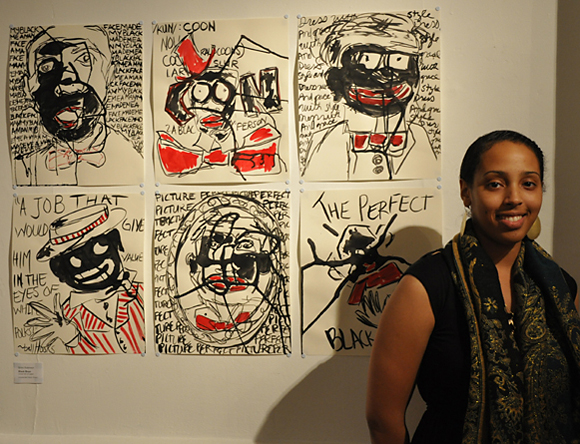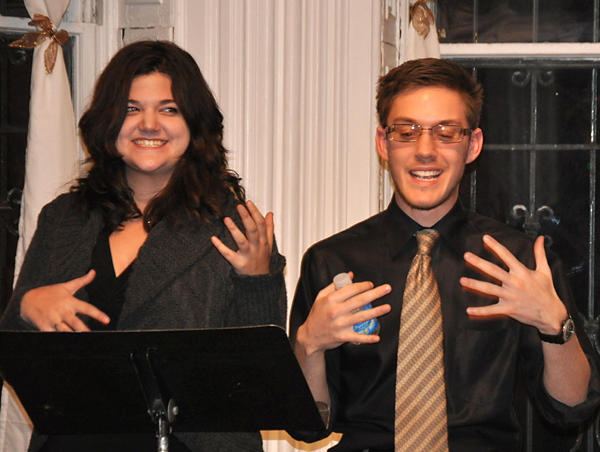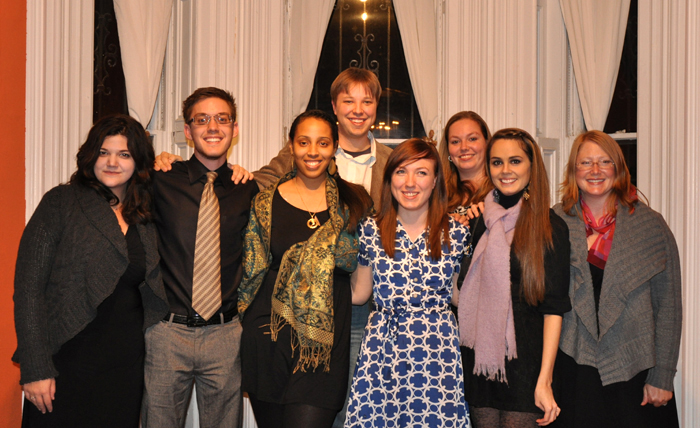Festival showcases students’ work on ACM Chicago Arts
“The character I’m going to read to you about is just waking up to find out she’s mute. She’s never been mute, so this is a surprise.”
With that introduction, Mandy Graber launched into a tense, gripping passage about a young woman who awakens to find herself a captive, with no clue as to where she is or the identity of her captors or why they are holding her. Or why she is unable to speak.
Graber’s tale was an excerpt from a novel she wrote on the ACM Chicago Arts Program. Her reading to a rapt audience on a cold December evening was part of the end-of-semester Arts Festival, where the program’s six participants presented works they created during their 15 weeks in Chicago.
|
|
At the Festival, Chicago Arts students with Program Director Dave Amrein (center, back) and visual arts workshop leader Martina Nehrling (right). |
Chicago Arts is one of ACM’s three Chicago Programs – along with Urban Studies and Business, Entrepreneurship, & Society – that blend experiential and academic elements to immerse students in the life of this dynamic city.
The Festival was a fond farewell to a busy, intense semester, showcasing the students’ independent projects in visual art, art history research, and fiction writing. “It’s really good to have a final critique with everyone seeing it,” said Sarah Jones, who took the lead in setting up the student-organized event.

Sarah Jones with her artwork in the Festival Gallery.
The venue for the Festival was the historic Keith House, one of the impressive mansions lining Prairie Avenue on Chicago’s Near South Side. Now a designated historic district, the neighborhood was once an exclusive enclave where the city’s most prominent families – such as Field, Pullman, and Armour – lived in splendor. For the night of the Festival, the students’ art filled most of the mansion’s main floor, and in the front parlor an overflow audience enjoyed the presentations.
It was clear throughout the Festival that the students were inspired by their experience in Chicago and flexed their creative muscles in new ways. “Everyone stepped outside of his or her comfort zone this semester and was rewarded for it,” observed Program Director Dave Amrein.
For Ripon College student Stephanie Lasson, a sculptor, that meant departing from the eclectic materials she typically uses. “I usually work with stuff you’d find in a hardware store, I guess that’s the best way to put it,” she said. “I use chicken wire a lot.”

Stephanie Lasson with her sculpture.
At the Festival, Lasson exhibited her piece titled “A Labyrinth through Memory,” an elaborate pair of dollhouse-like replicas, built from memory, of a house Lasson lived in as a child and the house her boyfriend lives in now. The replicas are complete with ceramic furniture and even kitchen appliances that she sculpted from porcelain clay.
“I was playing with the idea of how, depending on the memories you’ve had, they can either cause you to remember or forget certain things about the location,” according to Lasson, who said that while some rooms came back to her in minute detail, she drew a complete blank on others.
Artistic connections from campus to Chicago and beyond
While Chicago proved to be a venue for artistic growth into new areas for the students, connections with their artistic lives on their home campuses remained vibrant, too.

Britni Robinson with some of her artwork in the Festival Gallery.
Britni Robinson, a Carleton College student who grew up in Chicago, arrived at the program in September with an idea in mind – to explore black masculinity in her art – but stepped outside of her usual medium of oil paint to create works in India ink on paper. “I do like painting a lot, so this was a different experience,” she noted.
Robinson’s works combine text and drawings, and she did a lot of research last summer to find text, such as the quote from W.E.B. DuBois that she used as the basis for one of the pieces she exhibited at the Festival. The text in other pieces came from song lyrics and from the writings of educator and writer bell hooks.
“I was looking at hip-hop and comparing it to history of the black male,” she said. “That’s what I’m going to do for my senior project (at Carleton), and I thought this would be a way to help me get into that.” She added, “I’m still thinking about whether I want to do drawings or paintings” for the senior project.
50,000 words and lots of coffee
Michael Bonner, a poetry major from Colorado College, took the plunge into writing a novel during the program. “This is not what I normally tangle with,” he said of his 50,000 word draft, “but it’s also the form that I feel that I’ve been moving toward.”
Bonner and Mandy Graber, from Valparaiso University, were in the writing workshop led by Dave Amrein. They hatched a plan – a “possibly foolhardy task” in Bonner’s estimation – based on National Novel Writing Month. Each of them would write a novel in a month.
Graber had written novels before, but treaded into new territory this time around. “The novel I wrote this semester is really outside of my comfort zone,” she said. “It’s much more tilted towards plot and things like that instead of something intuitive or insightful.”

Mandy Graber and Michael Bonner take questions from the audience after reading excerpts from their novels.
They completed the first draft of their novels – having stretched the deadline a bit past the strict 31 days – and read excerpts at the Festival. Following the reading, they shared a bit about the writing process with the audience:
Michael: “We started living together in coffee shops at a point, especially as we were nearing the deadline. There was nothing else in our world but writing.”
Mandy: “We became antagonistic, and we’d make bets with each other, like, if I write more words than you today.”
Michael: “We were definitely at each other the whole time. We were tired.”
According to the two comrades in writing, reading at the Festival wasn’t the end of it. “We decided we’re going to hold each other accountable and go back and finish and rewrite and redraft and just try to get this thing to something that feels like a finished story,” said Graber.
“So at some point it will be a finished work, whatever we do with that,” Bonner chimed in. “Show it to our children someday?”
Program’s components inform and reinforce each other
The program’s four academic components – a Core Course with the other two Chicago Programs, an internship, an arts seminar on “The Creative Process,” and a workshop and independent study project – inform and reinforce each other.
Stephanie Lasson worked on her independent project at the ceramics studio where she had her internship, and other students also found that the internship was a springboard to their independent projects.
During her internship at an art therapy studio, Lake Forest College student Sarah Jones decided to try one of the therapeutic exercises alongside the children she was working with, so she created montages – interconnected two-dimensional works and objects – based on memories from different points in her childhood.

Molly Nelson presents her research on contemporary trends in portraiture.
Molly Nelson’s independent project grew out of her internship at the Museum of Contemporary Art and her ongoing interest in portraits and the artists who create them. An art history and art media double major at Beloit College, Nelson wrote a research paper examining trends in contemporary portraiture and presented her findings, illustrated by slides of artwork, at the Festival.
In her research, Nelson found that the demographics – gender, ethnicity, sexual orientation – of artists who create portraits tend to relate to whether, and how, the artists handle issues of identity in their works. As contemporary portrait artists address “a more intimate and nuanced side of identity,” said Nelson, they are redefining the genre of portraiture and breathing new life into it.
A challenge to explore
The Chicago Arts Program aims to challenge students to explore the creative process and to find their artistic voices. Surveying the Festival gallery, Martina Nehrling, a Chicago artist who led the program’s visual arts workshop, reflected on the students’ work and the just-completed semester.
“I’m so proud of the students,” said Nehrling, who also teaches art classes at Lake Forest College. “Their art is very personally informed. All of them shared with me how vulnerable they felt in their projects and that’s really mature territory, because then it’s worth doing.”
“Ultimately that’s what’s going to drive them to continue to make art if they choose to on their own,” she concluded. “One day, they won’t have assignments anymore.”
Links:
- ACM Chicago Arts
- ACM Chicago Programs
- More about Chicago Programs: Students Take the Plunge into Chicago’s Neighborhoods
All photos are courtesy of Sally Noble, Executive Director, Chicago Programs.







